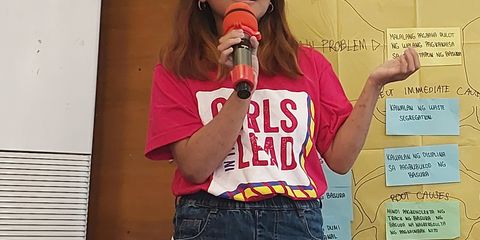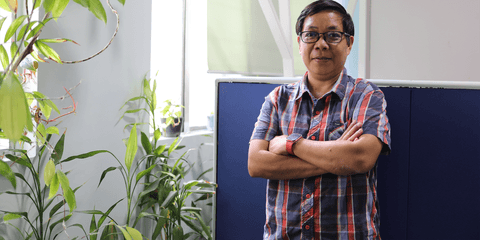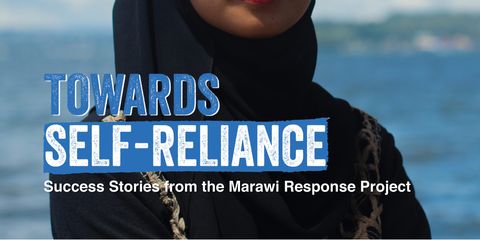Child-friendly spaces help Cotabato’s children recover
8 May 2020<strong>When a series of earthquakes struck the province of Cotabato on the island of Mindanao in the Philippines last October, around 175,000 children and youth were affected by the violent tremors that damaged or destroyed over 38,000 houses forcing families to find refuge in evacuation centres or erect makeshift shelters outside their ruined houses.</strong>
To provide children displaced by the earthquakes with a safe environment where they can play, learn and socialise, Plan International set up child-friendly spaces in the evacuation camps. These spaces are helping children return to a normal routine by offering activities, games and informal education. Here are some of the stories of the children who visit the centres each day.
When the earthquake hit, 12-year-old Dolly saw the ground open up and swallow her house whole.
“It was just the 3 of us children at home when the earthquake happened. I knew the advice of duck-cover-hold, but it was not enough. We rushed outside,” she recalls. “It was as if an explosion was happening underground, with thundering sounds coming out of it. The ground was trembling.”
As soon as her parents were able to collect them, the family fled to the nearby city of Kidapawan. When things appeared to calm down after a few days, they tried to return to their home village. But, one after another, the tremors came reaching a magnitude of 6.6 on 29 October and 6.5 on the 31st.
The family eventually had to move to one of the evacuation camp, where Dolly, who used to happily help out with the house work, started to defy her parents. “It was not the same. I started to disobey them. I was always rattled,” she explains.
At the child-friendly space in the camp, Plan International provides psychosocial support services for children affected by the earthquake. Through structured play and activities, children are helped to process their thoughts and emotions.
The sessions helped Dolly feel much calmer and put her on the road to recovery. “To cooperate with the group and to help each other out, I also learned first-aid skills and I was able to help a classmate who had a loose tooth.”
Dolly now hopes that she will be able to continue her studies, become a doctor and support her family.
Eleven-year-old, Princess Yara, has lived with her grandmother for 5 years. But when the earthquakes hit, their house was damaged and she had to move in with her aunt while her grandmother sleeps in a tent.
A fifth-grade pupil, Princes Yara treasures her time at the child-friendly space, particularly the drawing exercises and storytelling sessions. “The child-friendly space is important for me because it makes children happy. It helps us stop thinking about what happened, because we enjoy the play sessions,” Princess Yara says.
Princes Yara and her family also received water kits and purification solution from Plan International. “The water kits have reduced my stress in fetching water. I am also sure that drinking it is safe because of the solution and purifier it came with.”
As soon as 12-year-old Jolo stepped into his classroom, the first of 3 earthquakes happened. “Everyone was crying. We were afraid. When the quake stopped, our teacher instructed us to get out of the building, sit down, and wait for our parents to pick us up,” Jolo recalls.
When Jolo and his father reached home, he saw their house had been completely destroyed. For the second time that day, he cried. Jolo recollected how much his family, especially his sister who is now abroad, worked hard to build their house.
“After the earthquake, I found it difficult. It was very traumatic for me,” he says. “There were nights that I woke up sobbing because of nightmares about the quake. It was difficult to go back to bed. I dreamt about the earth shaking and the ruined fields.”
Jolo’s upland community is in one of the most devastated areas in Cotabato. Their village now has prominent fissures, landslides and the ground is unstable rendering it a ‘no build zone’ meaning it was impossible for the family to return and rebuild their home.
Now living in one of the evacuation camps, he regularly joins in with the child-friendly space activities. With trusted and experienced facilitators guiding them, internally displaced children like Jolo are helped to deal with the stress they feel, regaining their sense of normalcy and hope.
“The sadness and fear within me slowly drifts away at the sessions. I stopped thinking about what happened,” Jolo explains. “We need to work together. Practice teamwork. Have fun and listen to our facilitators.”
“We were in school having an exam, when it started shaking says 12-year-old Reza Mae. We were on the third floor and the wall started to disintegrate.”
Although their house remained standing, a huge crack by the front door made the family feel unsafe so they decided to relocate to an evacuation camp where Reza Mae joined the child-friendly space. “It helped with my recovery,” she says “The fun activities helped my fear of aftershocks.”
Reza Mae also regularly attends a temporary learning centre in the camp with around 40 other student. “I miss my normal school,” Reza Mae says. “It is very hot inside the learning centre. We lack chairs, but our teachers are doing their best. Most of my friends have already transferred to different areas. I am the only one left here.”
Angel, 16, used to feel scared whenever a sudden wind blew or there was a slight knock to her chair. Fragments of bad memories from the October earthquakes still linger. Angel distinctly remembers each date, each place, the people she was with and what she was doing when each earthquake struck.
“The first one, I saw my cousin under a chair pinned down by rubble. The second jolt, I was in school, but when I came home it was already impossible to enter our house. On 31 October, I was at home. Alone,” Angel recalls. “Our house was completely knocked down, my neighbours thought I hadn’t made it out.”
The child-friendly spaces focus on young people’s psychosocial needs helping their recovery. Split into various age groups, young people like Angel gather a few times a week to take part in sessions that help them process their thoughts and emotions, as well as build a supportive community among them.
Aside from the trauma that the earthquake induced, part of the process is also about the sudden changes brought by being displaced. “This is the first time I have stayed in an evacuation camp. Everything is completely different to what I am used to. We sleep here. We also study here. I needed time to adjust,” Angel explains.
Angel is a regular attendee at the child-friendly space sessions. “I thought it was the end of the world,” she says, “I am better now.”
As well as being active participants at the child-friendly space, cousins Reanie and Kimberly, assist with the facilitation of play sessions for the younger children.
“We are glad that we can help the children in our community – that they can be helped to recover from the earthquake and learn how to handle their fears,” Reanie says.
The child-friendly spaces help improve children’s psychosocial well-being by strengthening and nurturing their cognitive, emotional, and social development. The spaces also serve as venues to identify vulnerable and at-risk children so they can be referred for additional support.
“We are happy for the opportunity to help. We don’t think like victims anymore, but rather as support to other children,” says Kimberly.
Both Reanie and Kimberly believe that it is important to have activities for children to help them manage their stress. “Being young people ourselves, we have the ability to connect with the younger ones and comfort them when they are afraid.”
NOTES: Plan International’s child-friendly spaces and activities are financially supported by the Swedish International Development Cooperation Agency (SIDA) and the START Network. This disaster recovery project is a joint initiative by Plan International and our local partner, the Integrated Resource Development for Tri-People and Balay Mindanaw.
Categories: Emergencies


